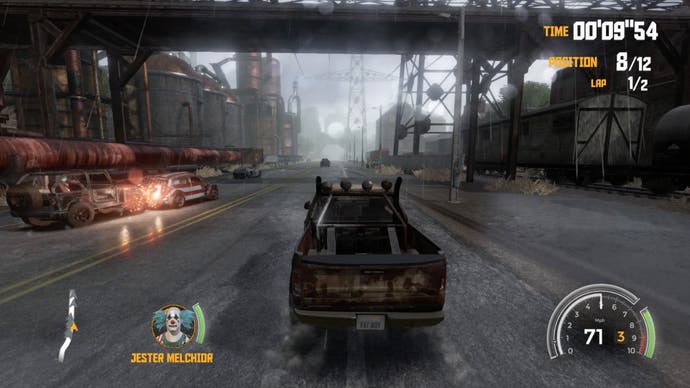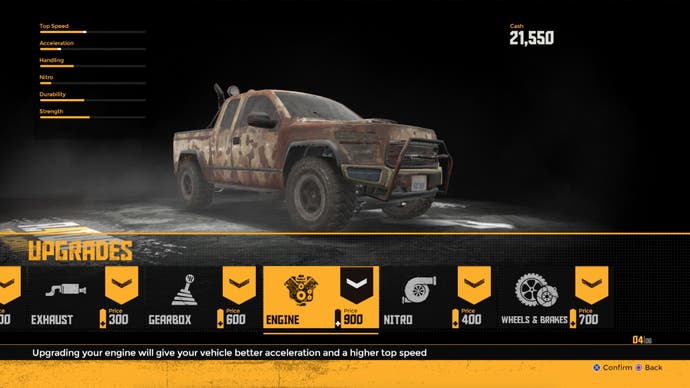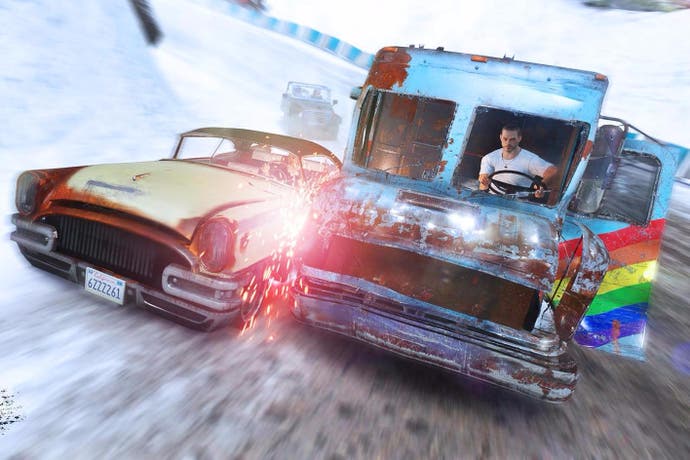Flatout 4: Total Insanity is a welcome return to form for the series, but stalls on innovation
Reinventing the wheel.
The fact that Flatout 4 even exists after the tragic car crash that was Team6's Flatout 3 is an achievement in itself, so having a new developer, Kylotonn in the driver's seat and not BugBear (the original creators of Flatout) could be seen as a rather unnecessary risk.
Nevertheless, Kylotonn has done a great job in redeeming the series, capturing the look and feel of fan favourite Flatout: Ultimate Carnage with none of the game-breaking bugs that made Flatout 3 such a nightmare to play. However, so keen is Flatout 4 to atone for the series' recent past, it forgets to put its own stamp on things.
That's not such a bad thing, really. For fans of Ultimate Carnage there's a real sense of deja vu when booting up Flatout 4. Everything from the yellow and black hazard tape decals on the menu screen through to the no name bands pumping out bland pop rock and ska-light tracks oozes familiarity.
This particular cover version also brings along gameplay that's often on par with BugBear's earlier games, especially when it comes to handling which has just enough pendulous weight to make sliding as satisfying as it should be.
Building up your boost is once again achieved by colliding with your opponents and the various destructible objects that litter the racetracks. It's this added risk/reward element that gave Ultimate Carnage an extra shot of adrenaline and turned it from a generic stock car racer into something akin to an action scene from Mad Max: Fury Road.
Battling against you for first place is a rather aggressive AI which will often try to force you into immovable objects or give you a cheeky clip to the rear bumper and spin you out. It's a literal pain in the arse when it happens, especially as it means losing a few places as you reset yourself onto the track, but crucially it rarely feels unfair.

For solo racers, Flatout 4's lengthy career mode features 20 tracks in total, all set in classic, well worn Flatout locations like drainage canals, lumberyards, and rocky deserts. It's worth pointing out that half of those tracks are just mirrored versions of themselves (bar a couple of figure 8 tracks) but multiple routes through each and plenty of hidden shortcuts keep things varied enough that you'll hardly notice.
Included in the career's championship cups is a small glimmer of novelty- a new race type called Assault that is Flatout 4's wannabe Mario Kart mode. Instead of earning your boost the traditional way, here it slowly builds up over time and can be spent on powerups like bollards that rise up from the ground behind you or an explosive radial burst that can be used to flip overtaking opponents. While the risk of banking your boost for a potential attack can prove to be an exciting gamble, overall the mode feels a little too punishing. The aggression of the AI combined with dozens of explosives means that your driving skills often take a back seat to blind luck which can severely hamper your progress through a cup.
As a diversion to the constant racing, players can also test their mettle in a series of quick fire challenge events in the Flatout Mode. Series veterans who played Carnage Mode back in 2007 will instantly recognise the available events, from the Destruction Derby style deathmatches and Carnage Race score attacks to the sadistic Stunts that proved to be a fan favourite when they were introduced to the series in Ultimate Carnage.
Nowadays these Stunt events do seem rather old hat though. Where once upon a time torturing the poor driver was a hilarious novelty, now they feel like tired filler material. This isn't helped by the fact that a number of Stunts are lifted directly from Ultimate Carnage, including High Jump, Long Jump and Stone Skipping, leaving only a handful of originals added to the roster.
Continuing on with the theme of overfamiliarity, just like previous games in the series, there's no split screen multiplayer in Flatout 4. Plugging the local multiplayer gap instead is a pass-the-pad party mode that allows up to 8 players to compete against each other across the full line-up of stunt events. It's entertaining enough that it might pass an hour or so at a house party, but beyond that it'll go untouched by the majority.

As a budget title it's not without its problems. It's a bit glitchy at times - occasionally debris from buildings you've driven through can attach itself oddly to your bonnet, betraying gravity by floating slowly up and down rather than following the short, sharp bumps and bounces of the car.
More concerning for racing purists though, is the drop in framerate when multiple vehicles are involved in collisions with each other and the environment. It's not severe enough to impact the gameplay in a negative way, but enough to be make you aware that the game is struggling to keep up with all the anarchy.
How all this translates to online play is yet to be seen. Empty pre-launch servers mean I've been unable to test it, which is a shame as I fondly remember the beautiful chaos a full lobby of racers can wreak on a figure 8 track. Judging by my experiences with the single player though, as long it's stable, online multiplayer will be just as satisfying and moreish as it was in both Flatout and Ultimate Carnage.
Whilst every facet of Flatout 4 is an marked improvement over Flatout 3, overall it does little invigorate or improve on anything that Ultimate Carnage achieved. In fact, with presentation and gameplay that wouldn't look out of place on the last generation of consoles, Flatout 4 is the closest you could get to a remaster of Ultimate Carnage without it actually being a remaster.
Lack of originality aside, Flatout 4 provides a welcome return to the classic gameplay of the often-brilliant BugBear titles. If you're happy with a no frills throwback to something you enjoyed playing 10 years ago then it's worth a punt, just don't go expecting anything more than that.

